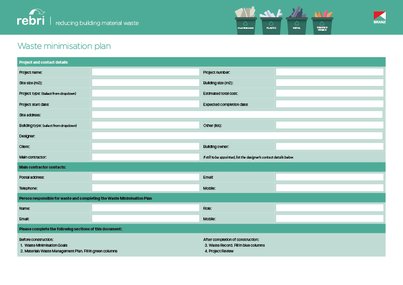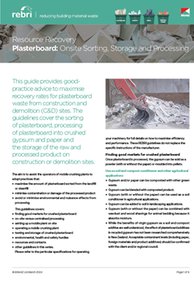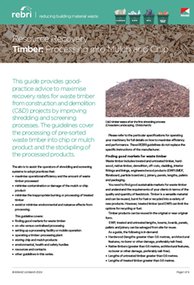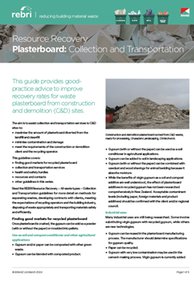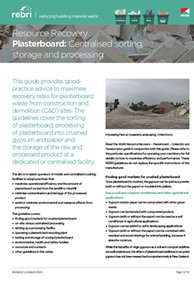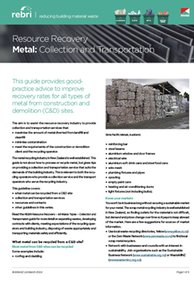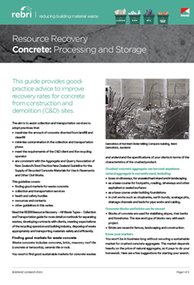REBRI Waste minimisation plan (PDF)
The waste minimisation plan is a helpful tool that can assist you in a few different ways.
This plan provides a framework for:
- Outlining who is responsible for managing waste on site
- Setting waste minimisation goals
- Recording the different types and amounts of waste from your project
- Describing recycling/reuse methods for each material
- Identifying waste destinations and how it is being transported
- Monitoring your progress
- Describing communication and training used to support and encourage participation from everyone on site.
- Reviewing the project – you can identify what went well and what can be improved next time.
We recommend using this REBRI Waste minimisation plan with Adobe PDF reader for data capture.
Updated: 24 September 2024
REBRI Resource Recovery Plasterboard: Onsite sorting, storage and processing (PDF)
This guide provides good practice advice to maximise recovery rates for plasterboard waste from construction and demolition (C&D) sites. The guidelines cover the sorting of plasterboard, processing of plasterboard into crushed gypsum and paper and the storage of the raw and processed product on construction or demolition sites.
The aim is to assist the operators of mobile crushing plants to adopt practices that:
- maximise the amount of plasterboard sorted from the landfill or cleanfill
- minimise contamination or damage of the processed product
- avoid or minimise environmental and nuisance effects from processing
This guideline covers:
- finding good markets for crushed plasterboard
- on-site versus centralised processing
- setting up a mobile plant on site
- operating a mobile crushing plant
- testing and storage of crushed plasterboard
- environmental, health and safety hurdles
- resources and contacts
- other guidelines in this series
REBRI Resource Recovery Timber: Processing into Mulch and Chip (PDF)
This guide provides good practice advice to maximise recovery rates for waste timber from construction and demolition (C&D) projects by improving shredding and screening processes. The guidelines cover the processing of pre-sorted waste timber into chip or mulch product and the stockpiling of the processed products.
The aim is to assist the operators of shredding and screening systems to adopt practices that:
- maximise operational efficiency and the amount of waste timber processed
- minimise contamination or damage of the mulch or chip product
- minimise the inappropriate burning or processing of treated timber
- avoid or minimise environmental and nuisance effects from processing.
This guideline covers:
- finding good markets for waste timber
- on-site versus centralised processing
- setting up a processing facility or mobile operation
- operating a timber-processing plant
- storing chip and mulch products
- environmental, health and safety hurdles
- resources and contacts
- other guidelines in this series.
REBRI Resource Recovery Timber: Collection and Transportation (PDF)
This guide provides good practice advice to improve recovery rates for all types of waste timber from construction and demolition (C&D) sites.
The aim is to assist the resource recovery industry to provide collection and transportation services that:
- maximise the amount of waste timber diverted from landfill and cleanfill
- minimise contamination and damage
- meet the requirements of the construction or demolition client and the recycling operator.
This guideline covers:
- finding good markets for waste timber
- collection and transportation services
- health and safety
- resources and contacts
- other guidelines in this series.
REBRI Resource Recovery Plasterboard: Collection and Transportation (PDF)
This guide provides good practice advice to improve recovery rates for waste plasterboard from construction and demolition (C&D) sites.
The aim is to assist collection and transportation services to C&D sites to:
- maximise the amount of plasterboard diverted from the landfill and cleanfill
- minimise contamination and damage
- meet the requirements of the construction or demolition client and the recycling operator.
This guideline covers:
- finding good markets for recycled plasterboard
- collection and transportation services
- health and safety hurdles
- resources and contacts
- other guidelines in this series.
REBRI Resource Recovery Plasterboard: Centralised sorting, storage and processing (PDF)
This guide provides good practice advice to maximise recovery rates for plasterboard waste from construction and demolition (C&D) sites. The guidelines cover the sorting of plasterboard, processing of plasterboard into crushed gypsum and paper and the storage of the raw and processed product at a dedicated or centralised facility.
The aim is to assist operators of mobile and centralised crushing facilities to adopt practices that:
- maximise operational efficiency and the amount of plasterboard sorted from the landfill or cleanfill
- minimise contamination and damage of the processed product
- avoid or minimise environmental and nuisance effects from processing.
This guideline covers:
- finding good markets for crushed plasterboard
- on-site versus centralised processing
- setting up a processing facility
- operating a plasterboard recycling plant
- testing and storage of crushed plasterboard
- environmental, health and safety hurdles
- resources and contacts
- other guidelines in this series.
REBRI Resource Recovery Metal: Collection and Transportation (PDF)
This guide provides good practice advice to improve recovery rates for all types of metal from construction and demolition (C&D) sites.
The aim is to assist the resource recovery industry to provide collection and transportation services that:
- maximise the amount of metal diverted from landfill and cleanfill
- minimise contamination
- meet the requirements of the construction or demolition client and the recycling operator
The metal recycling industry in New Zealand is well established. This guide is not about how to process or recycle metal, but gives tips on providing a collection and transportation service that suits the demands of the building industry. This is relevant to both the recycling operators who provide a collection service and the transport operators who serve the recycling industry.
This guideline covers:
- what metal can be recycled from a C&D site
- collection and transportation services
- resources and contacts
- other guidelines in this series.
REBRI Resource Recovery Concrete: Processing and Storage (PDF)
This guide provides good-practice advice to maximise recovery rates for concrete from construction and demolition (C&D) projects by improving crushing, screening and stockpiling processes.
The aim is to assist the operators of crushing and screening systems to adopt practices that:
- maximise operational efficiency and the amount of concrete crushed and screened into chip product
- minimise contamination and maximise the quality of the chip product
- avoid or minimise environmental and nuisance effects from processing and storage
This guideline covers:
- finding good markets for crushed concrete aggregate
- on-site versus centralised processing
- setting up a processing facility or mobile plant
- operating a concrete-processing plant
- testing and storage of crushed concrete product
- environmental, health and safety hurdles
- resources and contacts
